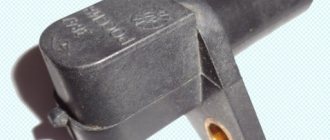Suddenly I had some free time and decided to make a small addition while reading the comments to the review.
“Author, are you satisfied with fuel consumption, what is the real value for 10 thousand km?” (c) Nekro (the author’s punctuation and grammar are preserved).
Indeed, the topic of fuel consumption remained practically unsolved.
Now I will try to fill this gap.
At the moment, the car’s mileage across the expanses of the Great and Mighty Motherland has exceeded 14,500 km. There was winter, spring, and summer began in the life of the car, which means we can already draw conclusions about the fuel consumption of the car.
And so, honestly about fuel consumption on the Lada Vesta SW Cross 1.8 l, 5AMT.
If we take it on average, in city mode, with the climate control always on, small warm-ups in the summer and large warm-ups in the winter:
Fuel consumption of Lada Vesta on 3 engine modifications
Fuel consumption is an important criterion for a car, because Lada Vesta is a car in the middle price segment. This means that its buyer is not sitting on an oil pipe. Along with the technical characteristics of the car, a person is interested in the fuel consumption of the car he is buying. Because a lot of money is spent on gasoline, the Lada Vesta is economical in this regard when compared with previous AvtoVAZ models, as well as with competitors’ models.
The fuel consumption of the same Vesta modification is not the same. Here are a few examples of what causes gasoline to be wasted faster:
- driver's driving style; engine size (1.6 or 1.8);
- seasons (winter, summer);
- uniform tire pressure and size;
- use of additional equipment (air conditioning, tape recorder);
- road conditions (city, highway);
- engine malfunction (any changes in the internal combustion engine lead to an increase in consumption, if the listed points are excluded, then it’s time to think about diagnostics).
type of installed gearbox (robot, manual);
For example, in the city, gasoline consumption increases due to frequent standing at traffic lights and in traffic jams. The engine spends additional resources on starting and shifting gears, consuming 1-2 liters. less on the highway, where the car does not stop and drives in one mode and in a higher transmission gear. When idle with the engine running, the car operates in idling mode, during which fuel burns. As a result, such idle consumption results in 10 liters spent, less kilometers traveled - the car was stopped, the gasoline flew into the atmosphere.
For the basic configuration of Vesta, the sedan's fuel consumption rate is from 7 to 10 liters per 100 kilometers of vehicle mileage. This is indicated by the manufacturer. The indicators are unchanged for West in other body styles: St. Cross and station wagon, and in trim levels: Classic, Comfort, Luxe. Fuel consumption figures vary due to a number of reasons. On the highway, the 106 hp engine burns gasoline. and a robotic gearbox with a minimum of equipment used is 5.3 liters. And a loaded 1.8 on a manual, even in winter, can exceed 12 liters. 92 gasoline.
Why do excess gasoline consumption occur?
Lada Vesta Fuel consumption rates for the Lada Vesta vary by a large number of factors:
- consumption occurs during frequent acceleration and braking;
- if the internal combustion engine and its systems are faulty, the fuel consumption deviates from the norm;
- AI-95 burns out faster than the 95 version;
- if the owner uses air conditioning or other additional automotive equipment, actual fuel consumption increases;
- in winter, consumption naturally increases;
- You should carefully monitor the tire pressure, and you should not overload the vehicle beyond the prescribed maximum;
- Timely gear shifting on a manual transmission prevents fuel from being wasted.
It is always worth taking into account that the figures given on paper do not quite correspond to what will happen in reality. According to statistics, an automatic transmission always “eats” less fuel than an automatic transmission.
Characteristics of fuel consumption on Lada Vesta engines
Modern cars strive to show savings in consumables and fuel, and the Lada Vesta consumes an average of 8.5 liters. goes the same way. As it turned out, fuel consumption depends on a lot of reasons, together they eat up fuel: Engine characteristics, additional equipment, frequent starting from traffic lights, idling, open windows make it difficult to streamline and consumption increases. Dynamic starting and frequent braking also affect consumption. You start abruptly from a traffic light and brake after 100 meters - more gasoline will be burned. There are many reasons, but there are calculations and observations for each Lada Vesta engine - let’s look at them separately!
Factors that increase consumption
- curb weight of the vehicle;
- engine volume;
- type of pre-installed gearbox;
- size, height, width of tires;
- style and manner of management;
- condition of machine components;
- frequency of use of equipment in the car;
- temperature regime overboard.
Related link:
What kind of oil to pour into the Lada Vesta engine. Expert advice on choosing
Conclusion
Regardless of the type of preinstalled transmission, it is quite possible to reduce the “appetite” of the motor if you adhere to the described recommendations.
To reduce fuel consumption as much as possible, fill with AI-95 gasoline. In suburban mode, do not exceed the average speed of 90 - 95 km/h. The maximum permissible threshold is 100 km/h.
There is an opinion that filling third-party chemical additives helps reduce the “appetite” of the engine, gives power and acceleration dynamics. Service station fuel workers are wary of such statements, as they believe that this is more a marketing ploy than real savings. Of course, the final decision is up to the owner of the technical device.
Appetites of the VAZ 21129 engine
The domestic product VAZ 21129 (1.6, 106 horses) can be equipped with two types of boxes and is often found on Lada Vesta. Gasoline consumption for cars with a manual transmission is at 9.3 liters in urban mode and 5.5 liters for suburban mode. Numbers for the AMT robot: 8.9 - city, 5.3 - suburban. The actual amount of fuel burned corresponds to the calculations of the manufacturer. In general, Vesta with a 1.6 engine consumes 7 liters in the combined cycle. 95 gasoline is recommended, but the engine can handle AI92.
Engine 1.8 (122 hp)
In most versions with a 1.8-liter engine, the same robotic gearbox is installed. The average consumption in such a pair is 7.2 liters, which is not bad for 122 “horses”. In more detail, urban consumption is 9.3 liters per 100 km, and in the suburban cycle – 6 liters per 100 km.
And only one configuration of this engine comes with a manual transmission - this configuration is called “Anniversary Luxe”. The average consumption in this version is 7.5 liters per 100 km. Unfortunately, only 500 models were produced in this configuration and not all of them were equipped with a manual transmission (at the buyer’s request). Let's hope that in the near future AvtoVAZ will begin producing this version of the engine and gearbox on an ongoing basis.
Thanks for subscribing!
How much does VAZ 21179 consume?
The latest version of the AvtoVAZ engine is VAZ 21179, produced since 2016, volume 1.8 and power 122 horses. It is equipped with two types of gearboxes - manual transmission and AMT. Fuel consumption per 100 km with a 5-speed manual transmission in the urban cycle is 10.7 liters, in the suburban cycle - 6.4. For Vesta, equipped with a 5 AMT gearbox with a 21179 engine, consumption in the city is 10.1, on the highway - 7.7. In mixed mode, the engine uses 8 liters of fuel per 100 kilometers and is filled with 95 gasoline. This engine is installed on new Lada Vesta models, which have even more additional functions (equipment) - in fact, a larger amount of fuel is used, about 10 - 12 liters in the city.
FakeHeader
Comments 49
Now it consumes 13.5 liters, in winter it’s under 16 with warm-ups, normal consumption. In the summer 11 around the city.
Probably too much anyway...
If the average speed is 12 km/h, where does the consumption of 8 liters come from)) on the highway it’s regularly 5.5 liters) so this kind of consumption doesn’t scare me at all. My previous car consumed 25 liters, and although according to the passport it’s no more than 15 in the city.
Probably too much anyway...
Inspect the catalyst, there was such a case that exactly the consumption was high, in the end it just burst and that’s it... they replaced it under warranty and lo and behold, the consumption dropped and the car flew off.
In winter the same consumption. Try other dressings. I'm onions now... I'm refueling, because... I filled up 20 liters while growing, drove 160 km and it ran out. I put it on the bow. 20 l. I drove 190 km and then stopped watching. My runs are 98% city, 2% highway, when on the highway I drive 100-110 km/h it drops to 8.2 l/100. And in the village in winter it even reached 13-15, warming up and low mileage, it takes longer to warm up than you drive.
For that you did not have an instant consumption of 29.99 liters. Since I started the car in the morning after a frost, the engine began to trouble and there were pops and check engine sounds from the exhaust pipe, and so it lasted for about 15 minutes until the car warmed up, during which time it consumed 8-10 liters
Regularly when accelerating it shows 29.9))
I didn’t have it when the car was stationary without pressing the gas
At work, I drive around the city by car, and for the report I have to reset the reading every day. So, the average consumption is different each time, it is from 9.5 to 12.5 liters. The firmware is from Paulus. The average consumption is influenced by many factors, and there is no point in looking at how others do... If you want to find out the average consumption, then we do this - we go on the highway, reset the average consumption to zero, drive at least 100 km at a speed of 80-110 km/h, and most importantly no sudden overtaking or braking. Then you can judge the average consumption.
Reasons for increased fuel consumption of Lada Vesta
The cost of gasoline consumption today is taking a significant toll on your wallet. It’s rare that a Vesta owner won’t notice that gas mileage has increased. High fuel consumption often indicates a car malfunction, but this is not always the case. Let's look at the reasons for the increase in gasoline consumption following the example of the Lada Vesta Cross SV.
On the mechanics, everything depends on the driver’s experience, but even incorrect gear shifting will increase the car’s fuel consumption. The engine speed has increased, the gearbox continues to transmit torque in the previous gear, no shifting occurs, and naturally more energy and gasoline are consumed, respectively. With the right gear, at the right speed, the car would have already gone further, so the fuel is wasted.
Lada Vesta 2022 - owner review
So, we will talk about Vesta SV. I think this car is interesting to many. As well as comparison with other cars in the same price category (+/-).
Let me make a reservation right away: this is the first car with front-wheel drive in the last 5 years.
Why Vesta SV: - we needed a sedan/station wagon with low fuel consumption - a fairly spacious interior, including for rear passengers - a large trunk - a comfortable suspension for ours. How can I put it mildly? potholes, in places where there should be good asphalt.
I must say that I entered the Lada salon purely by chance, after a test drive of Solaris (in the back seat I rest my head against the ceiling, suspension.), Rio (suspension is so-so), Rio X-Line (good car, but 0 discounts, on trade -inu 0, on loan - 0, gifts - 0). Sandero and Logan also looked fleetingly (both were not impressed).
After much calculation (is it worth taking a VAZik? My attitude towards the wonders of our automobile industry is so-so. The exception is Shevik), it was decided to take the SV (not a cross), in white (with the tinting of the rear hemisphere it looks very good), in Luxe Multimedia configuration. Maximum speed without heated rear seats and armrest for rear passengers.
The price at that time was 791,000 rubles per car. Among the additional features: 1. tinting of the rear hemisphere 2. anti-corrosive 3. floor mats and trunk 4. wire for the recorder 5. separately winter tires Khaka 5 on stamps 6. alarm with auto start (Starline) 7. a little later insured with CASCO
First impressions: - there is a lot of space in the cabin - the trunk is very comfortable (there are sections under the trunk floor for everything, even lower - a spare wheel and a jack with keys) - not bad control, adequate anti-skid and ESP, anti-rollback. - a rear view camera (on the Shevik there was no one, on the Sportage in the rear view mirror - it’s not very convenient, but on the Vesta it’s fully functional, with adequately functioning parking sensors that even signal about curbs)
Of the minuses: 1. oak plastic (but does not creak). However, Solaris/Rio/X-Lain are plastics of the same quality. 2. At first, 2nd gear and reverse were indistinctly switched on. Now everything seems to be fine. 3. the pebbles make a good sound in the wheel arches 4. the engine with a belt 5. an undisguised GLONASS system button (you just want to “poke” it by mistake)
Currently the mileage is 1 thousand km. Nothing fell off, everything works)))
I will add more as I use it, sorry for the photo, the car is a bit dirty.
Gasoline acceleration and combustion indicators
Braking and repeated acceleration in city mode are always present. However, the driver can reduce their sharpness to a minimum. The more Vesta accelerates and brakes, the higher the fuel consumption per 100 km. Lada, like any other car, loves a quiet ride, without jerking, and besides, this is harmful for the robot.
Gasoline with an octane rating of 92 burns faster than gasoline of 95, which means Vesta needs more of it every 100 km. It is recommended to fill Vesta with 95 gasoline, with the exception of the HR16 DE-H4m.
Video - Reduce consumption
A new, unusual car from Tolyatti, the Lada Vesta, which appeared on the automobile market in 2015, immediately attracted the attention of both ordinary car enthusiasts and specialists. They are surprised by many things: good dynamics, high level of safety, appearance of the car, fuel consumption of the Lada Vesta. Today, many potential buyers are interested in the tactical and technical performance characteristics and fuel indicators before choosing one or another vehicle model.
How to reset the average fuel consumption on a Lada Vesta?
So, you have excluded the factors influencing the increased fuel consumption of Vesta. How to determine what the consumption is now? It is necessary to reset the consumption indicators of Vesta’s on-board computer, but this is not as simple as, for example, the ninth family of VAZs.
With the ignition on, press both buttons of the left switch twice simultaneously. In the menu, according to the speedometer entry, select average consumption. Now hold the top button for about 3 seconds. As soon as the flow rate flashes, release it, then press it again until it stops flashing. Press the bottom button to exit the menu.
You can do it even simpler by using the old-fashioned method: just wait until the light comes on, or remember the division of the gas tank arrow. Then fill up with 10 liters and reset the mileage counter. Ride calmly until the light flashes again - when it flashes, look at the kilometers traveled.
Reducing fuel consumption on a Lada Vesta saves money and extends the life of your engine and transmission. The key to normal consumption is careful driving and careful handling, and this has never harmed anyone.
Lada Vesta jerks during acceleration, dips. There is a solution
Regardless of which engine is installed on the Lada Vesta, 1.6-liter (VAZ 21129) or 1.8-liter (VAZ 21179), each of them is controlled by electronic systems. Incorrect operation in transient modes, or more simply jerking, dips, jerks during start-up and acceleration, jerks when shifting gears can occur for various reasons. Fuel pressure is often not taken into account.
Reviews
| № | Positive |
| 1. | Nikolai Petrovich , 44 years old (otzovik.com): in my car the average consumption is about 6.5 liters per hundred. The indicator is good, before that there was a Priora, there was more. |
| 2. | Semyon Arkadyevich , 40 years old (www.zr.ru): I drive carefully, on the highway 90 - 95 km/h, no complaints about the fuel equipment. |
| 3. | Maxim , 22 years old (autobann.su): in general, I’m happy with the car, but at idle the speed suddenly increased (1100 rpm). My friends recommended replacing the fuel filter; it was most likely clogged. If it doesn’t help, then I’ll go to a service station for diagnostics. |
| 4. | Timofey , 33 years old (lada-vesta.net): the car is new, good price-quality ratio. This is not what was previously on previous modifications of Lada. |
| 5. | Arkady Gavrilovich , 43 years old (otzovik.com): my positive review of the Lada Vesta car. I live in a small town, it’s hard to find a better car. My recommendations for car enthusiasts. |
| 6. | Dmitry Semenovich , 45 years old (www.zr.ru): for the second year the car “sleeps” on the street, starts with a half-turn, the fuel pump works at 100%. |
| 7. | Vladimir , 20 years old (autobann.su): unlike the Lada Grant, Vesta has a number of advantages and improvements. Special thanks to the manufacturer for low gasoline consumption. |
| 8. | Vyacheslav Petrovich , 43 years old (lada-vesta.net): I drive around the city a lot, traffic lights, congestion, I expected more “appetite”, but Vesta is great, saves money. |
| 9. | Konstantin , 30 years old (otzovik.com): I take care of my equipment, carry out maintenance in a timely manner, I haven’t noticed any significant savings, but I’m happy with the car. |
| 10. | Gennady Stepanovich , 43 years old (www.zr.ru): over three years of operation, I contacted the service station several times for fuel equipment. Diagnostics did not reveal any critical breakdowns, just minor ones. I consider the consumption of 7.1 liters to be high for the Lada Vesta 1.8. |
| 11. | Vladislav , 35 years old (autobann.su): my positive review of the Lada Vesta, the car is economical, although not everyone agrees with this statement. |
| Negative | |
| 12. | Nikolaevich , 44 years old (www.zr.ru): I have a robotic version of the gearbox, it doesn’t show less than 8.4 liters per hundred. I think this is a lot, I will contact the service station for diagnostics under warranty. |
| 13. | Sergey , 27 years old (otzovik.com): in the urban cycle with a manual (Vesta 1.6) consumption is over 7.1 liters per hundred. According to the instructions, it should be less than 6.4 liters. I think this is a big expense for Vesta. |
| 14. | Mikhailovich , 45 years old (autobann.su): after a year of active use, I noticed a sudden increase in fuel consumption. I don’t know why this is so, obviously the fuel equipment has “flyed”. Comrades recommended contacting the official service under warranty. |
Related link:
Recommendations from experts on choosing fog lights for Lada Vesta
Why does the Lada Vesta twitch, symptoms
Loss of power and even jerks when changing gears may well not be assessed very objectively. For example, with a manual transmission, an inept driver can shift in such a way that passengers feel overloads of 4g. But that's not what we're talking about now.
Failures in the operation of VAZ 21129 (1.6 l) and VAZ 21179 (1.8 l) cannot be called a generic disease, but the problem occurs quite often. However, symptoms of incorrect engine operation in transient modes can tell the mechanic a lot. And there are enough symptoms:
- Dips only on a cold engine , after warming up the operation returns to normal.
- Jerking on a hot engine .
- Jerks only at start , that is, when starting from a stop, when changing from idle.
- High fuel consumption due to failures.
- Incorrect operation in transient conditions , accompanied by poor starting.
- A whole bunch of problems with the Check Engine light on .
As you can see, there are enough symptoms and they are somewhat different, but the essence of the problem is the same - Vesta twitches, the engine runs rough.
Reasons for Lada Vesta failures
Accordingly, there are also plenty of reasons for such pigish behavior of the engine. The most common of them:
- Poor mixture. This is a separate problem with its own set of problems. You can suspect anything - from a tired fuel pump, pressure reducing valve, right down to the injectors.
- Misfires . In most cases, this is due to faulty spark plugs or spark plugs that do not match engine parameters, broken high-voltage wires, or faulty coils. Lastly, check the correctness of the ECU firmware.
- Air leak in the intake manifold. This is partly what causes the mixture to become lean. The air leakage zone can extend to both the intake manifold corrugation and the manifold gasket; there may be ruptures and damage in the vacuum tubes.
- Broken or outdated firmware of the electronic engine control unit.
- Sensor malfunctions .
- Poor contacts on sensor or ECU connectors.
- Fuel rail pressure
Measuring pressure in the fuel rail of Lada Vesta
It is worth talking about the last point in more detail, since it is typical for Lada Vesta with VAZ-21129 and VAZ-21179 engines.
Lada Vesta. INSUFFICIENT OIL PRESSURE (LOW OIL PRESSURE WARNING LIGHT IS ON)
| List of possible faults | Diagnostics | Elimination methods |
| Low engine oil | According to the oil level indicator | Add oil |
| Oil filter is faulty | Replace the filter with a known good one. | Replace the faulty oil filter |
| The bolt securing the auxiliary drive pulley is loose | Check bolt tightness | Tighten the bolt to the specified torque |
| Clogged oil receiver mesh | Inspection | Clear the mesh |
| Skewed, clogged oil pump pressure relief valve or weakened valve spring | Inspection when disassembling the oil pump | Clean or replace the faulty relief valve. Replace the pump |
| Worn oil pump gears | Determined by measuring parts after disassembling the oil pump (at a service station) | Replace the oil pump |
| Excessive clearance between bearing shells and crankshaft journals | Determined by measuring parts after disassembling the oil pump (at a service station) | Replace worn liners. If necessary, replace or repair the crankshaft |
| Insufficient oil pressure sensor is faulty | We unscrew the low oil pressure sensor from the hole in the cylinder head and install a known-good sensor in its place. If the warning light goes out while the engine is running, the inverted sensor is faulty | Replace the faulty low oil pressure sensor |
Jerks, jerking of Lada Vesta and pressure in the fuel rail
Tired spark plugs, decrepit high-voltage wires, cracks in the corrugation of the intake manifold - all this can be checked and replaced simply. And immediately evaluate the result. However, in most cases, Lada Vesta owners complain that such manipulations are useless.
General diagram of the Lada Vesta fuel system. 1 – fuel rail; 2, 3, 4, 5 – fuel line; 6 – fuel module; 7 – gas tank.
The problem with VAZ engines 21129 and 21179 is insufficient pressure in the fuel rail . Here's the thing. Everyone knows that the path of gasoline from the gas tank to the cylinders looks like this:
- Gasoline is pumped through a coarse filter into the fuel module by an electric fuel pump.
- The fuel is then supplied to a mechanical pressure regulator, which is also built into the fuel module. The task of the pressure regulator is to ensure fuel pressure in the system within 3.50-4.50 atm .
- Then gasoline at nominal pressure follows the fuel line and enters the ramp with injectors.
- The injectors are turned on sequentially every 720 degrees of crankshaft rotation, and the fuel spray time is controlled by the ECU depending on the operating conditions of the engine and the pressure in the system.
In short, yes. We pay special attention to the second point of this list.
There are nuances here, since for a 1.8-liter engine the normal fuel pressure in the rail is 3.80 atm, and for a 1.6-liter engine it is 3.50 atm.
Cases have been observed where the wrong pressure regulators were installed from the factory in the fuel modules for both engines; the maximum that could be obtained from measurements was 3.60 atm in the ramp.
Naturally, with such pressure there is no way to talk about any correct work. And this is an even better option. In some cases, the pressure regulator made it possible to maintain only 2.7-2.85 atm at idle. Hence the dips and jerking when accelerating.
A pressure of 3.5 bar is generally considered normal, according to officials.
Therefore, our task is to try to increase the fuel pressure to the maximum permissible 4.50 atm . How to do it?
Lada Vesta. ENGINE COOLING FAN RUNS CONSTANTLY (EVEN WHEN THE ENGINE IS COLD)
| List of possible faults | Diagnostics | Elimination methods |
| Open circuit in the coolant temperature sensor or its circuit | The sensor and circuits are checked with an ohmmeter | Restore contact in electrical circuits. Replace the faulty sensor |
| Fan relay contacts do not open | Checking with a tester | Replace the faulty relay |
| The ECU or its circuits are faulty | Check the ECU or replace with a known good one | Replace the faulty ECU |











